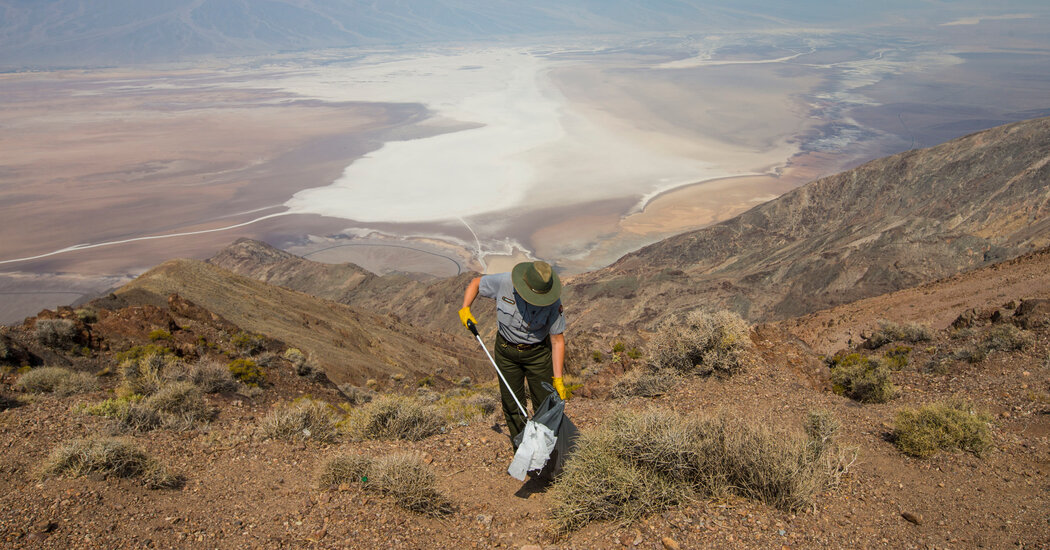
An Interior Department order will end the sale of single-use plastic products at national parks and on other public lands in the United States by 2032.
Sales of plastic water bottles and other single-use plastic products will be phased out at national parks and on public lands in the United States over the next decade, the Interior Department said this week.
Deb Haaland, the secretary of the Interior, announced the measure on Wednesday. As the manager of 480 million acres of federal land, she said, the department has an obligation to play a leading role in reducing plastic waste, including food and beverage containers, bottles, straws, cups, utensils and disposable plastic bags.
“As the steward of the nation’s public lands, including national parks and national wildlife refuges, and as the agency responsible for the conservation and management of fish, wildlife, plants and their habitats, we are uniquely positioned to do better for our Earth,” she said in a statement.
The Interior Department’s order reflects an intensifying global push to address plastic waste pollution and the challenges of getting rid of it, as recycling alone, hampered by shortfalls in collection and transport, has not been enough for the United States to stay ahead of mountains of plastic.
The department acted in response to an executive order from President Biden to reduce waste.
In a first step, the department’s bureaus and offices will be required to report how they will phase out single-use plastic products by 2032, the Interior Department’s order said. They will also be required to come up with ideas for how to change public behavior, such as adding water fountains and bottle-filling stations.
Oceana, a marine conservation organization, estimated that the Interior Department’s move would curb “millions of pounds of unnecessary disposable plastic in our national parks and other public lands.”
“Our national parks, by definition, are protected areas,” Oceana’s plastic campaign director, Christy Leavitt, said in a statement, adding that “we have failed to protect them from plastic for far too long.”
Disposable plastic water bottles have been a target of policymakers for years. In 2011, the Obama administration encouraged the National Park Service to stop selling them. But the Park Service, under the Trump administration, discontinued the policy in 2017, saying that the ban “removed the healthiest beverage” while allowing sweetened drinks and that only about two dozen of the 417 National Park Service sites had adopted it.
The Interior Department’s order falls in line with similar measures that countries and companies have announced to reduce the amount of plastic that ends up in landfills and waterways. Tens of millions of tons of plastic pollute the oceans every year, dramatized by images of marine life strangled by plastic rings and accounts of birds that have died from ingesting plastic waste.
Environmentalists, companies and policymakers have approached the problem from many angles, from cafe counters to legislative halls.
Paper straws have taken the place of plastic ones in coffee shops and restaurants in Britain. Companies have developed sheets of soap that come in a packet to replace laundry detergent in heavy plastic jugs. Some global hotel chains have phased out miniature toiletry bottles, installing pump dispensers instead. Beverage companies are getting rid of plastic rings that bind six-packs of soda and beer, replacing them with cardboard.
In Britain, stores charge for plastic bags, and the authorities have banned the manufacturing of products containing plastic microbeads. In April, the government imposed taxable limits on the amount of nonrecycled plastic packaging that can be used in a product as an incentive for companies to use recycled materials.
In March, representatives of 175 nations agreed to begin writing a global treaty that would restrict the explosive growth of plastic pollution.
The European Union’s ban on single-use plastics, including straws, plates, bags, cotton swabs and utensils — identified as the most common plastic waste on shorelines — took effect last July in its 27 member countries.
Nearly a year later, compliance has been patchy, despite the effort toward a unified approach. Industries and manufacturers of affected items have pushed back, said Piotr Barczak, the waste policy officer at the European Environmental Bureau, a network of environmental organizations.
“In countries where you can no longer buy those items, yes, you of course see much less of it on the beaches,” he said. “I would not put the responsibility or blame on people. It is up to the authorities to regulate producers and those who put it on the market. It is up to enforcement authorities to control it.”
